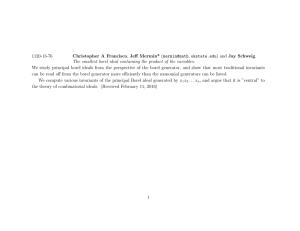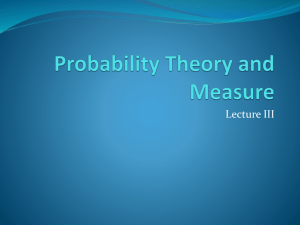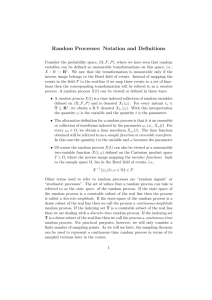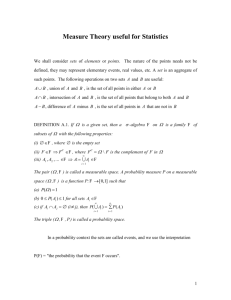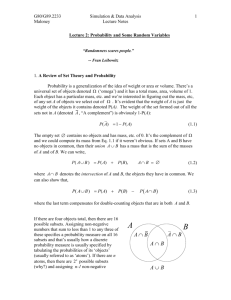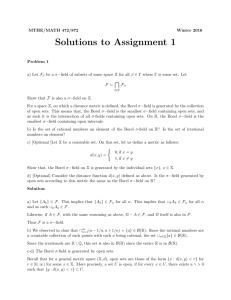The smallest Borel ideal containing the product of the variables Chris Francisco
advertisement
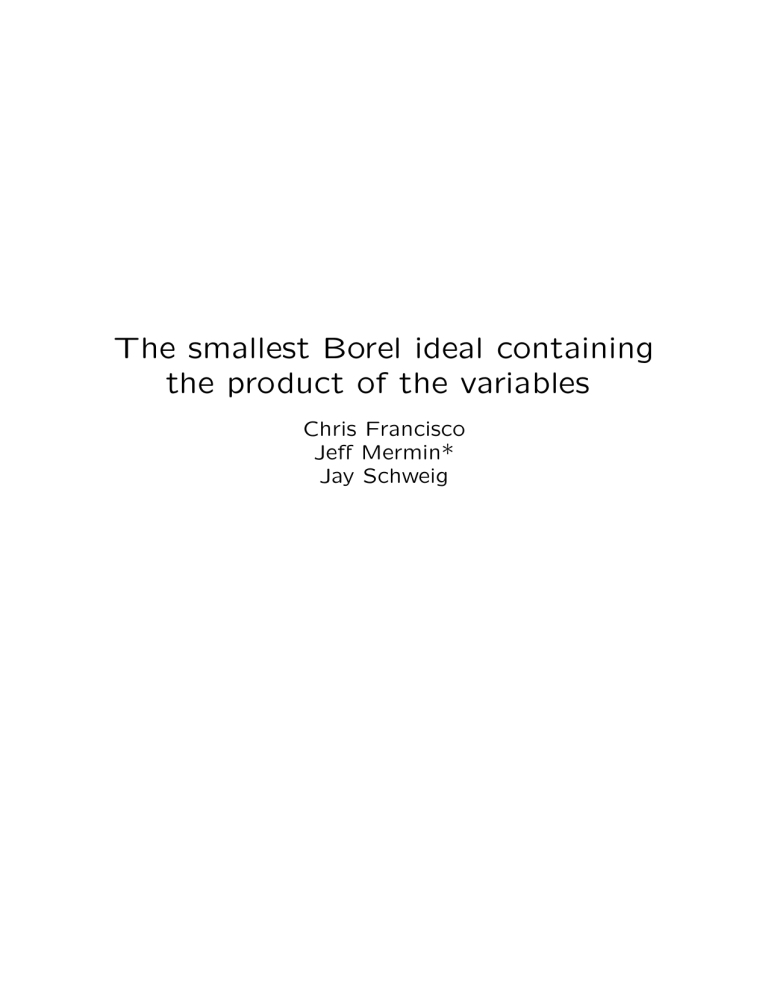
The smallest Borel ideal containing
the product of the variables
Chris Francisco
Jeff Mermin*
Jay Schweig
Let S = k[x1, . . . , xn] = k[a, b, c, . . . ], and let I
be a monomial ideal of S.
Definition: I is Borel if it satisfies the condition:
Let i < j and let g be a monomial
such that gxj ∈ I. Then gxi ∈ I.
Changing xj to xi is called a Borel move.
If m is a monomial, the principal Borel-fixed
ideal generated by m is the smallest Borelfixed ideal containing m. We call it Borel(m).
Examples:
Borel(abcd) = (a4, a3b, a3c, a2b2, a2bc, a2bd,
a2c2, a2cd, ab3, ab2c, ab2d, abc2, abcd)
Borel(xkn) = mk
Question: Given a principal Borel ideal B =
Borel(m), what can we determine without first
computing the traditional monomial generating set?
Question: Given a principal Borel ideal B =
Borel(m), what can we determine without first
computing the traditional monomial generating set?
Answer: Just about every invariant we care
about.
Let Ck = Borel(x1x2 . . . xk ). Then all the invariants of Ck are really nice.
Question: Given a principal Borel ideal B =
Borel(m), what can we determine without first
computing the traditional monomial generating set?
Answer: Just about every invariant we care
about.
Furthermore, all the invariants of Borel(x1x2 . . . xk )
are really nice.
Associated primes and
primary decomposition
Theorem (Classical): If B is Borel and P ∈
Ass(B), then P = Pq = (x1, . . . , xq ) for some q.
Associated primes and
primary decomposition
Theorem (Classical): If B is Borel and P ∈
Ass(B), then P = Pq = (x1, . . . , xq ) for some q.
Theorem: Suppose B = Borel(m) is principal
Borel. Then
B=
(x1, . . . , xq )k ,
\
where xq occurs in the “kth position” in m. For
example,
Borel(abcd) = (a)∩(a, b)2 ∩(a, b, c)3 ∩(a, b, c, d)4.
In particular,
Ass(Borel(m)) = {(x1, . . . , xq ) : xq divides m}.
In particular,
Ass(Borel(m)) = {(x1, . . . , xq ) : xq divides m}.
The associated primes of Borel(x1x2 . . . xk ) form
a saturated chain.
Hilbert functions and Betti
numbers
Suppose that S = k[a, b, c, d, e] and abc ∈ B is a
(classical) monomial generator.
Then abc contributes {a2bc, ab2c, abc2, abcd, abce}
to the degree-four part of B.
Hilbert functions and Betti
numbers
Suppose that S = k[a, b, c, d, e] and abc ∈ B is a
(classical) monomial generator.
Then abc contributes {a2bc, ab2c, abc2, abcd, abce}
to the degree-four part of B.
But a2bc = (a2b)c and ab2c = (ab2)c, so they’re
redundant.
Hilbert functions and Betti
numbers
Suppose that S = k[a, b, c, d, e] and abc ∈ B is a
(classical) monomial generator.
Then abc contributes {a2bc, ab2c, abc2, abcd, abce}
to the degree-four part of B.
But a2bc = (a2b)c and ab2c = (ab2)c, so they’re
redundant.
The contribution of each generator µ to higher
degrees depends only on its last variable.
Put wi(B) = #{µ : max(µ) = xi}.
If B is a Borel ideal generated entirely in degree
d, we have:
HS(B) =
X
td
wi(B)
.
n−i+1
(1 − t)
Furthermore, the graded Betti numbers of B
are
i − 1
X
βj,j+d(B) =
wi(B)
.
j
So we actually want to compute wi(B).
To compute the wi(B) for B = Borel(m), build
the Catalan diagram of shape m:
x1
x2
x2
x5
x6
...and fill it in like
Catalan’s triangle.
(Here, m = ab2ef = x1x2
2 x5 x6 .)
To compute the wi(B) for Borel(m), build the
Catalan diagram of shape m:
x1
x2
x2
x5
x6
1
1
1
1
1
1
2
3 3 3 3
4 7 1013 13
...and fill it in like Catalan’s triangle.
(Here, m = ab2ef = x1x2
2 x5 x6 .)
To compute the Betti numbers of Borel(m),
build the Catalan diagram of shape m:
x1
x2
x2
x5
x6
1
1
1
1
1
1
2
3 3 3 3
4 7 1013 13
Then plug in t + 1 to the generating function
on the last row.
g(t) = 1 + 4t + 7t2 + 10t3 + 13t4 + 13t5
g(t + 1) = 48 + 165t + 245t2 + 192t3 + 78t4 + 13t5
betti res module borel monomialIdeal(ab2ef ) :
0
1
2
3
4 5
total: 48 165 245 192 78 13
5:
48 165 245 192 78 13
I = (a, b, c, d)3:
1 1 1 1
1 2 3 4
1 3 6 10
g(t) = 1 + 3t + 6t2 + 10t3
g(t + 1) = 20 + 45t + 36t2 + 10t3
betti res borel monomialIdeal(d3) :
0 1 2 3 4
total: 1 20 45 36 10
0:
1 .
.
.
.
1:
. .
.
.
.
2:
. 20 45 36 10
I = Borel(abcd):
1
1 1
1 2 2
1 3 5 5
g(t) = 1 + 3t + 5t2 + 5t3
g(t + 1) = 14 + 28t + 20t2 + 5t3
betti res borel monomialIdeal(a*b*c*d) :
0 1 2 3
total: 1 14 28 20
0:
1 .
.
.
1:
. .
.
.
2:
. .
.
.
3:
. 14 28 20
4
5
.
.
.
5
Boij-Söderberg
decompositions
Let β(B) and β(S/B) stand for the Betti diagrams. For example, if B = Borel(abcd), we
have
.
.
.
.
.
.
.
.
.
14 28 20
.
β(B) =
.
.
.
.
.
.
5
1 .
.
.
.
.
.
.
β(S/B) =
.
.
.
.
. 14 28 20
.
.
.
5
The Boij-Söderberg theorems say that these
are positive linear combinations of the Betti
diagrams of pure Cohen-Macaulay modules.
Let B be a Borel ideal, generated in degree d.
Then the Boij-Söderberg decompostion of B
is given by the wi(B):
β(B) =
X
wi(B)β(Borel(xdi)).
Let B be a Borel ideal, generated in degree d.
Then the Boij-Söderberg decompostion of B
is given by the wi(B):
β(B) =
.
.
.
.
.
.
.
.
.
14 28 20
.
.
.
X
wi(B)β(Borel(xdi)).
.
.
.
.
.
.
. = 1. + 3
.
.
.
.
5
1
1
.
.
.
.
.
1 2
.
+ 5
.
.
.
.
.
.
1
.
.
.
.
. + 5
.
.
.
1
1
.
.
.
.
3
.
.
.
.
3
The situation with S/B is more complicated.
.
.
.
.
1
Let B be a Borel ideal, generated in degree d.
Then the Boij-Söderberg decompostion of B
is given by the wi(B):
β(B) =
.
.
.
.
.
.
.
.
.
14 28 20
.
.
.
X
wi(B)β(Borel(xdi)).
.
.
.
.
.
.
. = 1. + 3
.
.
.
.
5
1
1
.
.
.
.
.
1 2
.
+ 5
.
.
.
.
.
.
1
.
.
.
.
. + 5
.
.
.
1
1
.
.
.
.
3
.
.
.
.
3
The situation with S/B is more complicated.
.
.
.
.
1
When the dust clears, we get
!
β(S/B) =
X
wi+1(B)
wi(B)
d ),
−
β(S/m
i
wi(mn)d wi+1(mn)d
where B is generated in degree d, mi = (x1, . . . xi),
and n is sufficiently large.
When more dust clears, S/ Borel(x1x2x3) lies
at the centroid of its Boij-Söderberg face:
1
.
.
.
.
.
.
5
.
.
.
6
.
1 .
1 .
1
1
.
. .
. .
=
+
.
3 . .
3 . .
2
. 1
. 4
1 .
. .
1
.
. .
.
+
.
.
.
.
3
. 10 15 6
.
.
.
3
When more dust clears, S/ Borel(x1x2x3x4) lies
at the centroid of its Boij-Söderberg face:
1
.
.
.
.
.
.
.
.
.
.
.
.
. 14 28 20
.
.
.
.
1 .
1
. .
.
.
1
1
. . + .
=
.
4
4
.
.
. .
5
. 1
.
1
.
.
.
.
5
.
.
.
.
4
.
.
.
.
.
.
.
.
.
.
.
.
. 15 24 10
.
1
+
.
4
.
1
.
.
.
.
.
.
.
.
.
.
.
.
.
.
.
.
. 35 84 70 20
.
1
+
.
4 .
When more dust clears, S/ Borel(x1x2 . . . xn)
lies at the centroid of its Boij-Söderberg face:
n
X
β
S
Borel(x1x2 . . . xn)
!
= i=1
S
mn
i
β
n
!
